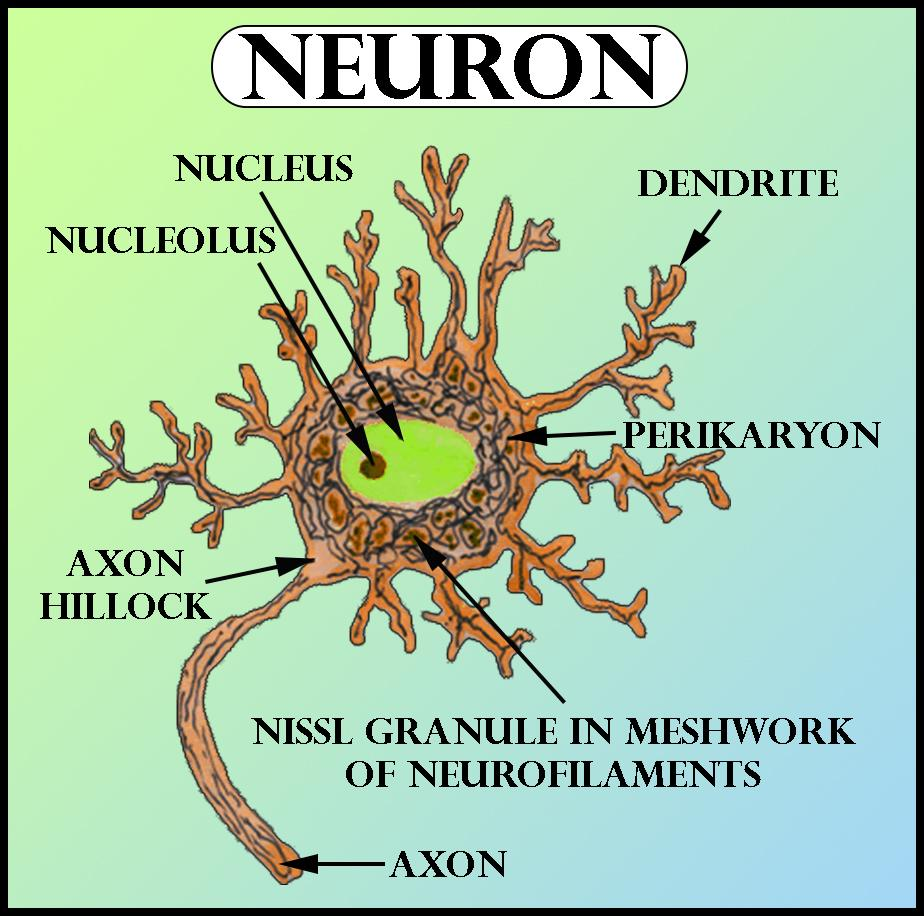
Nissl granules are found in
(a) Liver cells
(b) Nerve cells
(c) Kidney
(d) Heart
Answer
513.9k+ views
Hint: Nissl's granules are irregular parts of a rough endoplasmic reticulum that show attachment with ribosomes and polysomes helps in the synthesis of protein and it is found inside the cell body. The Nissl's granules are also known as neurofibrils.
Complete answer:
The neuron is divided into the cell body, dendrites and axon-
The cell body of the neuron is round, oval, pyramidal and star-shaped. It consists of cytoplasm with cell organelles and some granular bodies called Nissl's granules and fibres containing neurofibrils. The Nissl granules are made up of rough endoplasmic reticulum and with the attachment with ribosomes, it synthesises protein. It also helps in the transmission of the impulse. In dendrites, Nissl's granules and neuro-fibrils both are present and it conducts nerve impulse toward the cell body, by afferent process. Axon is a long fibre, whose distal end is branched and terminates out in form of the synaptic knob which possesses synaptic vesicles containing neurotransmitters. The nerve impulse passes from one neuron to the next neuron with help of the neurotransmitter acetylcholine. The conduction of nerve impulse in the axon takes place by the efferent process which means from the cell body to axon.

So, the correct answer is Nerve cells.
Note:
Axon arises from the axon hillock part of cotton which is the most sensitive part and possesses side branches called collateral fibres. In axons neurofibrils are present but Nissl's granules are absent. Due to the absence of Nissl's granules, the axon depends on the cell body.
Complete answer:
The neuron is divided into the cell body, dendrites and axon-
The cell body of the neuron is round, oval, pyramidal and star-shaped. It consists of cytoplasm with cell organelles and some granular bodies called Nissl's granules and fibres containing neurofibrils. The Nissl granules are made up of rough endoplasmic reticulum and with the attachment with ribosomes, it synthesises protein. It also helps in the transmission of the impulse. In dendrites, Nissl's granules and neuro-fibrils both are present and it conducts nerve impulse toward the cell body, by afferent process. Axon is a long fibre, whose distal end is branched and terminates out in form of the synaptic knob which possesses synaptic vesicles containing neurotransmitters. The nerve impulse passes from one neuron to the next neuron with help of the neurotransmitter acetylcholine. The conduction of nerve impulse in the axon takes place by the efferent process which means from the cell body to axon.

So, the correct answer is Nerve cells.
Note:
Axon arises from the axon hillock part of cotton which is the most sensitive part and possesses side branches called collateral fibres. In axons neurofibrils are present but Nissl's granules are absent. Due to the absence of Nissl's granules, the axon depends on the cell body.
Recently Updated Pages
Master Class 11 Business Studies: Engaging Questions & Answers for Success

Master Class 11 English: Engaging Questions & Answers for Success

Master Class 11 Computer Science: Engaging Questions & Answers for Success

Master Class 11 Social Science: Engaging Questions & Answers for Success

Master Class 11 Maths: Engaging Questions & Answers for Success

Master Class 11 Biology: Engaging Questions & Answers for Success

Trending doubts
Differentiate between an exothermic and an endothermic class 11 chemistry CBSE

10 examples of friction in our daily life

One Metric ton is equal to kg A 10000 B 1000 C 100 class 11 physics CBSE

Difference Between Prokaryotic Cells and Eukaryotic Cells

State the laws of reflection of light

Explain zero factorial class 11 maths CBSE




